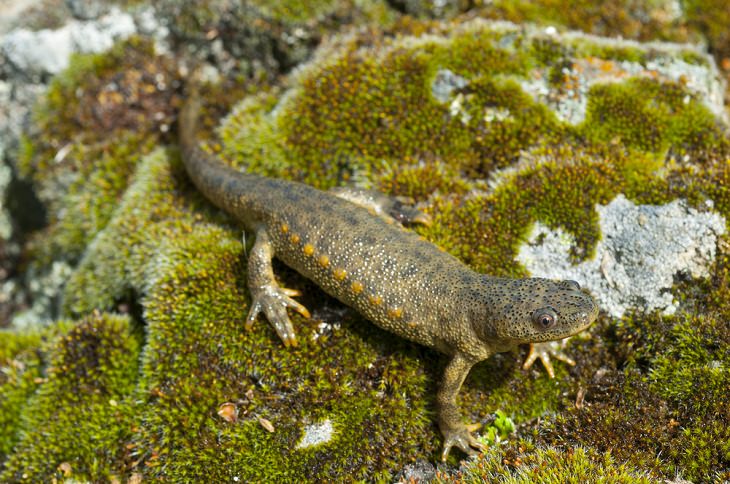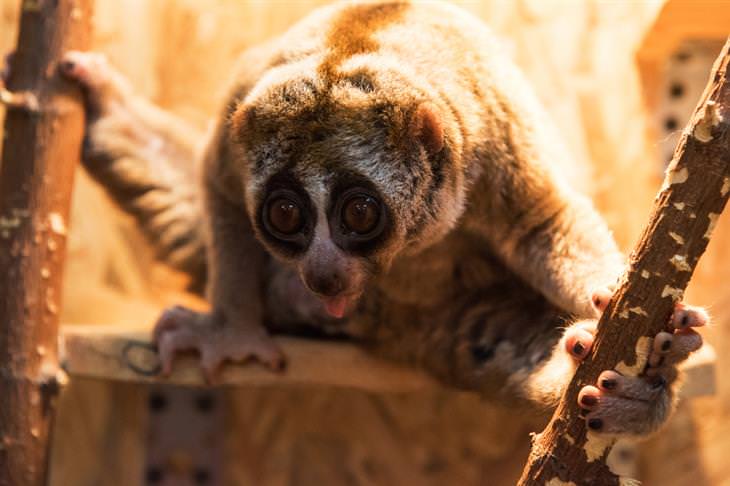The wilderness can be a cruel place, and survival isn’t always easy. To manage nature’s brutal dance of life and death, many animals develop unique defensive techniques to fight, kill, or escape from predators. For example, porcupines are famed for their sharp quills that help defend them against natural predators. Skunks spray an oily secretion stored in their perianal glands to repel enemies.
There are many types of defensive mechanisms in nature you may not be aware of. From a lizard that shoots blood from its eyes when threatened to ants that explode to protect their own, here are the craziest defense tactics in nature.
1. The Hairy Frog Breaks Its Bones When Threatened
This Central African frog seems to have leaped straight out of a horror movie. The hairy frog (Trichobatrachus robustus), also known as the “horror frog” or “Wolverine frog,” can break its own toe bones, push them through the skin of its toe pads, and use them as claws for defense. They regenerate the torn skin later and retract the claws, which are then covered with a protective layer of tissue until the frog needs them again.
2. The Texas Horned Lizard Shoots Blood From Its Eyes
The Texas horned lizard (Phrynosoma cornutum) is a scary-looking creature that squirts blood from the corners of its eyes to fend off predators like hawks, snakes, other lizards, coyotes, cats, and dogs. It does so by contracting the muscles around its eyes, which cuts off blood flow to the heart and floods the ocular sinuses. It then continues to contract those same muscles, increasing pressure on the thin sinus membranes until they rupture and release a stream of blood.
The stream of blood can go as far as 5 feet (1.5 m) and is mixed with a foul-tasting chemical. In biology, this process is called autohaemorrhaging or "reflex bleeding." If needed, the horned lizards can repeat this process several times within a short period. Sometimes, they autohaemorrhage to remove irritating particles from their eyes without fully rupturing their sinuses.
The Texas horned lizard also protects itself with the help of its sharp spikes and horns and by camouflaging itself in its native sandy environment.
3. Iberian Ribbed Newts Turn Their Ribs Into Spikes
When attacked, the Iberian ribbed newt (Pleurodeles waltl) pushes its ribs forward through its stretched skin to form spikes on either side of its body to deter predators. The exposed bones are then covered with a milky poisonous substance that seeps into the newt's skin and can cause immense pain to the attacker. Surprisingly, the mechanism doesn’t cause any harm to the creature, and it can perform it repeatedly if needed.
4. Sea Cucumbers Fire Their Internal Organs at Attackers
Sea cucumbers (Holothuroidea) appear as pretty harmless echinoderms (marine invertebrates like starfish and sea urchins), but they have a bizarre defense mechanism – they eject their own intestines and other organs at the enemy. This distracts their predator and enables them to swim to freedom. They violently contract their muscles together to expel their sticky internal organs, which can also contain a poison called holothurin. Many a time during this process, sea cucumbers can lose some of their organs. Fortunately, they can quickly regenerate lost body parts.
5. Pygmy Sperm Whales Create 'Poonado'
The pygmy sperm whale (Kogia breviceps) has an amazing anti-predator adaption. This dolphin-sized relative of the enormous sperm whale emits a reddish-brown fluid from its anus to distract its enemies. The liquid, which is stored within a unique sac-like bulging of their lower intestines, forms a dark cloud in the water and can be up to about 100 square meters (1,076 square km) in size. The dark cloud shrouds predators and gives the whale enough time to escape.
6. The Northern Fulmar Vomits a Stream of Stinky Goo at Predators
The northern fulmar (Fulmarus glacialis) is a beautiful sea bird found throughout the northern Atlantic and Arctic oceans. These chicks of these birds have a unique defense technique that you may find repulsive. When threatened, the fulmar chick projectiles a stream of putrid bright orange, stinky, sticky vomit unto its attacker. The oil in the vomit makes the predator's feathers stick together, making it incapable of flight. A good reason to keep your distance from these nesting birds, right?
7. Electric Eels Use High-Voltage Shocks To Stun Prey
The sleek and dark gray electric eel (Electrophorus electricus) can deliver incredibly strong electric shocks for self-defense or attack its prey. Its body contains electric organs with about 6,000 specialized cells called electrocytes. These run in rows along the length of its body and store power like tiny batteries. Electric eels leap from the water to directly electrify threats with a burst of at least 600 volts. This high voltage attack is similar to the effects of a Taser gun and is enough to disable the muscles of a fish or any predator.
8. 'Exploding Ants' Rip Themselves Apart To Protect Their Own
You really don’t want to mess with Malaysian exploding ants (Colobopsis saundersi). If a predator invades their nest, these ants violently rupture their large venom-filled abdomen, releasing a sticky, bright yellow fluid laced with corrosive toxins on their enemy. The ants die, of course, but their sacrifice can help save their colony from the attacker(s).
Related: 10 Animals That'll Teach You to Take It Easy
9. The Slow Loris Has a Toxic Bite
The slow loris (Nycticebus) looks like such an adorable animal. But don’t be fooled by its appearance alone. Native to southern Asia, this very slow-moving creature has glands near its armpits that ooze toxic oil. When the animal licks those glands, its saliva combines with the oil to concoct a deadly venom in a natural chemical reaction.
If the slow loris feels threatened, it sucks the poison from its underarms and delivers a toxic bite to its attacker. The bite can put the predator into an anaphylactic shock. Slow lorises are the only venomous primates.
Share this post with other nature lovers!




